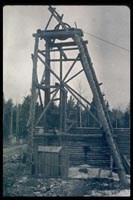
The Rainy Lake "Gold Rush" During the summer of 1893, a local prospector searched for gold in the Rainy Lake area. In late July of 1893, while camping on a small island near Black Bay Narrows, he discovered a gold-bearing quartz vein - the "Little American" discovery. Given the good news and gold-bearing specimens, a Black Hills miner was hired to secure a title to the island and arrange financing. Development of the Little American Mine proceeded rapidly in the spring of 1894, along with the growth of the nearby settlement of Rainy Lake City to support the areas newfound exploration and mining activities. Rainy Lake City was incorporated on March 17, 1894, and by early summer was a bustling community of several hundred people with a school house, bank, general store, hotels, restaurants, a newspaper, hardware store, butcher shop, and several saloons. Following the development of the Little American Mine, several other prospects saw extensive activity during the summer of 1894, including the Lyle Mine north of Dryweed Island, the Big American Mine on Big American Island, the Bushyhead Mine on Bushyhead Island, and the Soldier Mine on Dryweed Island. Despite all of the numerous attempts to make gold-mining a profitable activity on Rainy Lake, the low production of the mines resulted in a gold-bust by 1898. The "Boom" was over, and the Rainy Lake City school and newspaper office were closed down. By 1901 the city was a ghost town. |
Last updated: January 9, 2023
